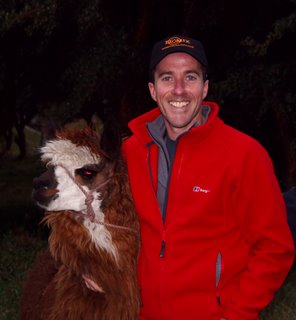 Adios mitad del mundo!
Adios mitad del mundo!I have had a great last couple of days in Ecuador. On Monday morning I flew back in to Quito for a trip to a rainbow trout farm 4000m up in the Andes north of Quito. I was collected from the airport by Dr Fabio Sala and his wife Cynthia. Italians by birth and an echinoderm (starfish) developmental biologist and an embryologist, respectively, by training, they co-run Biomix, a feed formulation company providing the trout industry in the region. Flying back in to the city at 3000m reminded me of the effect of the altitude experienced earlier in the trip. This time though there was no chance for acclimatisation as we headed northeast from Quito, and much higher up into the Andes. The scenery was spectacular…the same mountain range as we saw down in Chile but this time there was no snow…the mountains instead carpeted by lush grasslands and forest, even at 5000m above sea level.
After a couple of hours we reached Papallacha (pronounced ‘papayakka’), a tiny village and home to the trout culture research station run by Pedro Manuel Santistevan (you’ll remember his name from earlier in the blog). The research centre is supplied by hot and cold water springs straight from the Andes range and is of an excellent quality for trout culture. Pedro and Fabio proceeded to show me around the facility where I was lucky enough to have my first go at ‘stripping’. Naturally I was nervous, not wishing to embarrass myself with my lack of experience. However, keen to not let the side down I soon had my hands on one of the local females, a mature, plump specimen who luckily had benefited from a general anaesthetic in clove oil before I got my hands on her.
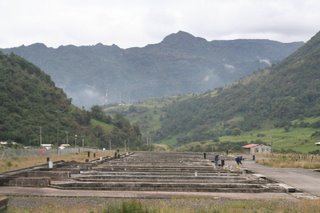
The trout research station at Papallacha. The 'hills' in the background are about 4500m above sea level. Beyond them in the clouds is a volcano that stands another 1000m above this. A pretty nice place to work.
While there may be those reading this who may be getting worried that I am about to illustrate the blog with unsavoury photographs of the episode, the more astute amongst you will have realised that ‘stripping’ is indeed a wholly organic way to collect sperm and eggs from the farms broodstock fish for onward breeding and for stocking the farms in the region. After a couple of attempts I soon had the hang of it and was collecting thousands of eggs from each female specimen. The males were next but I thought it best to let the experts handle these….
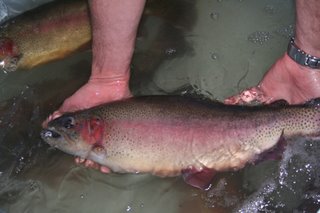
A broodstock female, ready for 'stripping'
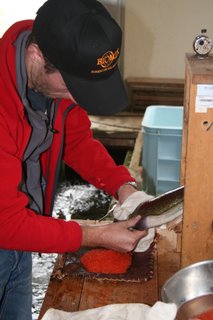
The process of egg collection from the female. Like I say, I drew a line at the males.
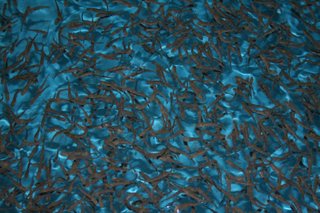
After a few weeks of magic...the fry appear. These are then grown on in the ponds until they are ready to make ceviche.
Continuing the theme from my trip to the prawn farm down in the Mangroves on Monday, lunch of course consisted of the locally produced organic trout, served ‘ceviche’ style with tomato, onion, lime and coriander. Lovely.
In the afternoon we headed back through the mountains and stopped off at one of the local trout farmers that Fabio provides with food. The scenery in the valley was reminiscent of the Scottish highlands, with a temperature to match. Quite a different sensation from being in the tropical climate of Guayaquil that morning! The farmer soon had us warmed up however with his local brew of wild fruits plus unknown extras. Just the confidence I needed to show my affection to one of the alpaca that were wandering around the farm (see above).
Next day was to be my final day in Ecuador and I must say it is pretty sad to be moving on from this amazing country. When I read about Ecuador’s biodiversity (officially the most biodiverse country on earth) I had pictured massive swathes of lush, humid rainforest that fulfilled this status. However, the reality of the country is quite different. Despite there being plenty of rainforest (it houses the eastern portion of the Amazon in the so-called Oriente region), the biodiversity comes not only from here but from the sheer variety of different habitat types that are found in what is essentially a very small country. You can travel from 5000m in the Andes to the tropical coastline within 30 minutes by plane, in doing so crossing lush lowlands and river valleys. Heading to the coast you move though dry scrub and fruit plantation into dry rainforest and mangrove. I did not even get to go investigate what lives below the waves, but with the much-publicised Galapagos just 600 miles offshore, the biodiversity of the aquatic habitat is also second to none. It truly is a special place and you can see why Darwin got so excited when he visited the region back in the 1800’s.
Just before heading out, I visited the Ministry of Environment in Quito to discuss a project being funded by the World Bank that is attempting to preserve this delicate habitat before the ravages of tourism and over-fishing blight this jewel in the South American crown. The project is interesting since it requires a careful balance between the fiscal requirements of a developing nation and the necessity to preserve what the tourists come here for in the first place. Issues such as ‘biosecurity’ were raised (the Galapagos has few natural predators and the introduction of vermin via tourist boats are a real threat to long term sustainability). For those in Cefas with an interest, expect some follow up from this meeting.
Finally, I would like to thank all of those new friends that have helped me to navigate and communicate my way through this amazing country. In particular, to Claudia Musello (ESPOL), Dr Sam Stern (CENAIM), Dr Stannislaus Sonnenholzner (CENAIM), Dr Paola Calle (ESPOL), Dr Sonya Mendoza (CSA), Alex de Wind (Bravita SA), Pedro Manuel Santistevan (CENAIC), Dr Fabio Sala (Biomix), Matt Hopkinson (Inspectorate), Leonardo Mariduena (Inspectorate), Colin and Nick Armstrong (Agripac SA). I hope that I can return the favour to you all one day.
I am heading to the USA tonight for the final week of my trip. I am bracing myself for a culture shift as I drop down into the states but am looking forward to spending some time at the University of Arizona where I will visit the excellent prawn disease research and monitoring facility run by Prof. Don Lightner.
I will see you when I get there.
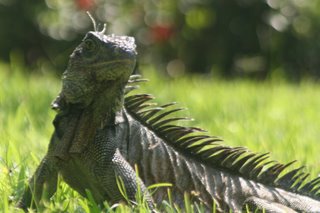
I'll sign off with one last picture of the Iguanas in the park in Guayaquil.
Hasta Luego Ecuador. I’ll be back!!

2 Comments:
I think your time away from Pip is finally getting to you.... just in this one blod entry you are pictured in a warm embrace with a "hairy horse" and only a few paragraphs further down your are doing something to a fish which I'm sure is illegal in 1/2 the western world.... Just because your a scientist doesn't make it right... and NO Grant just because you drew the line at the boy fish it doesn't make it any better!
no comment to either of you.
Post a Comment
<< Home